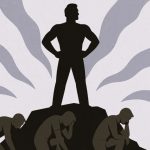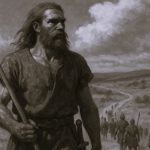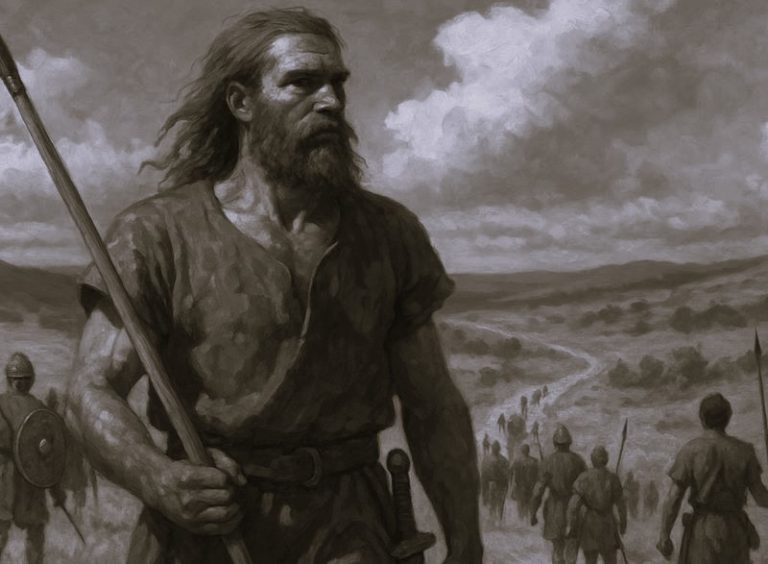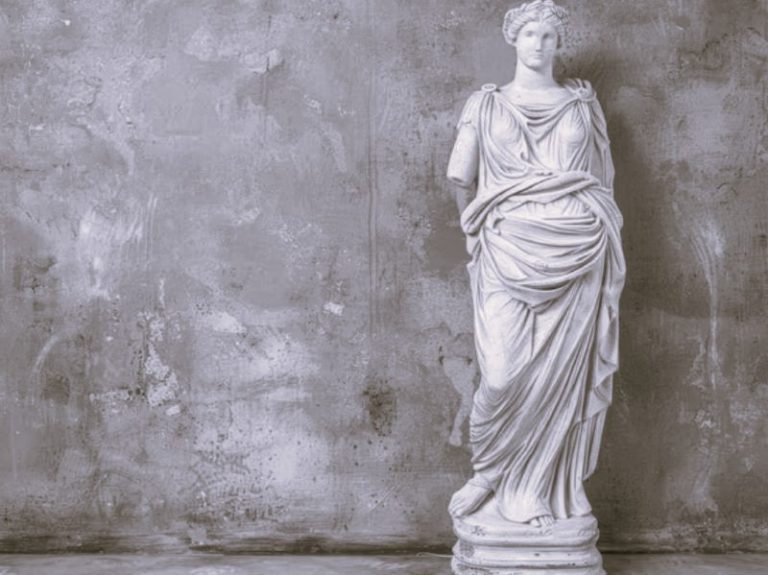

Many of Dubreuil’s American pictures are contrived to be indirect in their meaning.

By Dr. Dorinda Evans
Professor Emerita of Art History
Emory University
This article, Illusory Wealth: Victor Dubreuil’s Cryptic Currencies, was originally published in The Public Domain Review under a Creative Commons Attribution-ShareAlike 3.0. If you wish to reuse it please see: https://publicdomainreview.org/legal/
After supposedly stealing 500,000 francs from his bank, the mysterious Victor Dubreuil (b. 1842) turned up penniless in the United States and began to paint dazzling trompe l’oeil images of dollar bills. Once associated with counterfeiting and subject to seizures by the Treasury Department, these artworks are evaluated anew, considering Dubreuil’s unique anti-capitalist visions among the most daring and socially critical of his time.
In October 1893, an unidentified reporter for the New York World visited Victor Dubreuil’s studio on West Forty-Fourth Street to ask him about his deceptively realistic paintings of United States currency. Several of his pictures had drawn public interest when they were displayed over the bar in a Seventh Avenue saloon. What the journalist found, when the door opened, was a kindly, fifty-one-year-old, virtually penniless Frenchman who spoke heavily accented English and shared his accommodations with a young nephew. As the writer described Dubreuil, the artist had a bent, portly form, dark eyes, and a grizzled black beard. When he went out, he wore a wide-brimmed black hat. This recently recovered journalist’s interview reveals an educated man of strong opinions and many talents. And it helps fill a longtime gap in basic knowledge about Dubreuil and his cryptic, socially-critical images.1
Born to middle-class parents on November 8, 1842, he was baptized Marie Victor Théodore Dubreuil in the town of Ayron, near Poitiers. On the record, his father is listed as a landowner. From what is known, Dubreuil joined the French army as a soldier in his twenties and fought in the Second Franco-Mexican War as well as the Franco-Prussian War. Then he settled in Paris, working as the director of an exchange bank. On May 29, 1878, at age thirty-five, he married Virginie Lenoir, a widow fifteen years his senior. By the spring of 1881, he had become a socialist agitator and co-founder of a short-lived newspaper called La politique d’action. He also tried to found a norm-breaking African development company. According to his interviewer, the company would “do for France and Africa what the East India company did for England and India”, with the difference that “the workingman, not the capitalist” would reap the financial rewards. Apparently as part of this effort, Dubreuil stole more than five hundred thousand francs from his bank — in an action he justified as borrowing — leaving it bankrupt. On October 29, 1881, the Parisian newspaper La revue économique et financière carried a short notice of Dubreuil’s disappearance and speculated that he had gone to Holland. According to the paper, an extradition warrant had been issued against him for forgery and misappropriation of funds.2

Dubreuil arrived in New York on June 6, 1882, applied for U.S. citizenship, and found short-term employment as a stable boy for the banker Théophile Keck. In his flight to avoid prison, he left his wife behind and later divorced her. As the journalist reported, after four months of work in the stable, Dubreuil taught himself to paint still lifes, genre scenes, landscapes, and even portraits, so that he became, in his own words, “vairsateel” (versatile). During these first years in the United States, he also tried to increase his earning power through rather imaginative inventions, such as a special pulley-controlled pair of suspenders. When he became a citizen in 1888, however, his certificate of naturalization listed his occupation simply as “artist”.3
At the time of the New York World interview, Dubreuil was best known for trompe l’oeil images of legal currency, such as Take One. Similar pictures had been produced by some of his American contemporaries, including William Michael Harnett, since at least 1877. As in Harnett’s case, the illusionism of Dubreuil’s bank notes drew public admiration, which is why he was pursued for an interview. The reporter described two of his larger works on view at the Seventh Avenue saloon in some detail. The first, entitled Barrels O’ Money (unlocated), was an unusual depiction of unattainable wealth. It showed rows of oak casks filled with freshly minted treasury bills, topped with “heaping shovelfuls” of gold coins and sparkling jewels that spilled onto the floor. The second of these two paintings — an image of a bank robbery — was considered “the key” to the artist’s “aspirations, disappointments, joys and sorrows”. Certainly, it related to his past experience with the world of banking and his current poverty.4

Now called Don’t Make a Move!, the canvas, painted during a time of economic depression, is identified in the article as A Prediction For 1900; or, a Warning to Capitalists. This first title and visual evidence within the painting imply that the subject is an allegorical indictment of international banking. The artist himself, shown wearing his signature broad-brimmed hat and pointing a pistol at the viewer, and his “ex-washerwoman” pose as two bank robbers who, in their coarse clothing, are ostensibly victims of financial reverses.5 They face the spectator who, in the position of bank representative, is the real culprit and, in fear, has just knocked over a stool and discarded a newspaper. As the blank account ledger shows, no records have been kept, and the money is not in any order but, rather, stashed chaotically in a drawer. In this symbolic world, the upside-down image of Martha Washington visible on the dollar bill at the top of the pile of notes in the washerwoman’s outstretched right hand and the pointedly upended word “United” on a nearby bank note suggest the topsy-turvy state of the country. The discarded newspaper, a fictitious international publication entitled The Sport, produced in London but on sale for five “cents”, contains several satirical and anti-imperialist references, such as “Russian Republic” and “1810”, the year the paper was established. This is when Mexico, Argentina, Chile, Colombia, and Venezuela rebelled and called for an end to Spanish rule. Taken together, other legible words — “Salvator”, “Unidos”, and “Nihil” — imply crisis and general despair.6
The dominant theme appears to be horse racing, known as “the sport of kings”, with such legible words as “payday” and “European” accompanied by “Derby” and “Chantilly”, the location of famous racetracks in England and France, respectively. Racetrack betting was surely a metaphor for international speculation in currency values. The month and day of the newspaper, given as “Février 21”, likely alludes to the publication on this day in 1848 of Karl Marx and Friedrich Engels’ Communist Manifesto. With the future centennial year of 1900 added to this date, it becomes an ominous prediction of proletarian revolt. What the robbers have found, in their surprise visit, is an American bank in the act of gambling with the money of its depositors and an international situation that reverberates with the struggle of the disenfranchised. The word “Revolution” notably appears under the newspaper subheading “United States of America”.

Given that it was displayed in late 1893, Don’t Make a Move! almost certainly points to the severe financial panic and depression that began in January of that year. With a paper currency based on a bimetal standard and the general public’s anxiety over the continuance of deflation dating from the Civil War, the gold reserve of the United States Treasury fell below the legal limit, and, in response, the government stopped producing gold certificates. As the situation worsened, some American banks refused to pay cash for the checks of their own depositors or treated their depositors unequally. Hundreds of businesses and banks failed. At the time, one popular explanation was that British and eastern United States bankers were conspiring to force Congress to adopt a single gold standard, thereby increasing the value of the gold supply that they controlled. The economy did not recover until June 1894, and even this relief was followed within about a year by an economic recession.7
To be sure, not all of Dubreuil’s oil paintings were iconographically complex allegories; most were more salable images that showcased his ability to simulate reality in such a way as to fool the viewer. His painted illusions are particularly effective when the subject is a still life — a few dollar bills, a lithographic print, or a carte de visite, such as the one he copied of Grover Cleveland (White House Collection), probably while Cleveland was still president. But Dubreuil was too inventive to limit himself to meticulous copying for its own sake. The artist’s casks of currency, which he produced in a series of at least eight, are imaginary creations that appeal in a humorous way, calling attention to human greed. They also could be used, seemingly without his consent, as an irresistible lure in a saloon scam.8

Concerning the unscrupulous use of these images, we have the testimony of a young bookkeeper, William Applegate. In September 1894 he appeared as a witness before a New York State Senate committee charged with investigating New York City police corruption. Under oath, he described the activities of William Roach, perhaps Dubreuil’s greatest patron and the owner of the saloon in which the artist’s pictures appeared. According to Applegate, “Jimmy” McNally, a gang leader and opium addict from Jersey City, moved into the apartment above Roach’s saloon in January 1893 and began a “green goods” scam or “boodle game” involving Applegate and Roach. The victims made appointments with Roach to meet at the saloon and buy bags of “genuine” counterfeit currency, supposedly printed from stolen engraving plates. With “steerers” egging them on and treating them to liquor, the victims were shown real money (new bills supplied by Roach) as samples of what they were purchasing to convince them of the quality of the counterfeit bills. Then the bag containing the real money was switched with one containing sawdust or its equivalent as the victim turned to argue over the price. In a later version of the scheme a locked box was involved, and the victims were given a wrong key to delay discovery of the contents. What made the ruse particularly successful was that the dupes could not report it to the police without incriminating themselves as purchasers of counterfeit money.9
As Applegate explained, McNally was a lavish spender, “and to please him Roach had hired an artist to paint pictures of gold bricks, wads of greenbacks, bills of large denominations and the like”. These were placed in conspicuous parts of the room and were “meant to impress visiting ‘guys’ with ideas of untold wealth”. The visitors, usually from the countryside, were told that “there was plenty of ‘real stuff’ to be had, the same as portrayed in the pictures”. The real stuff would have been printed from the reused plates. On another occasion, Applegate testified that Roach and McNally were “the best of friends. They found a painter between them, and he made a lot of pictures of money, just like what we had in the bank roll, and they used to excite the greed of the victims by telling them that that was like the money they was going to buy”. The reporter who quoted Applegate added that the pictures that represented thousands of dollars “thrown about promiscuously, still hang on the wall behind Roach’s bar” and inspired not only the green goods victims but also neighborhood pickpockets still at large.10
At least two newspapers carried the saloon story as a relatively minor part of the larger police investigation, but one of them — the New York Herald — annoyed Dubreuil sufficiently that he responded. The Herald journalist, having elaborated on the evil impact of the pictures with regard to pickpockets, concluded that the paintings were “done by an old man who represented a million dollars on canvas three feet square for a fee of twenty dollars or so”. In Dubreuil’s reply to the editor, he wrote: “I painted the pictures referred to but was paid a great deal more than the sum mentioned and never believed, nor do I now believe, the pictures were intended to further any evil purpose. As I am well known on the west side as the painter of these pictures I trust, out of justice to me, you will print the above.” The Herald had condemned the artist by association, without a hearing.11
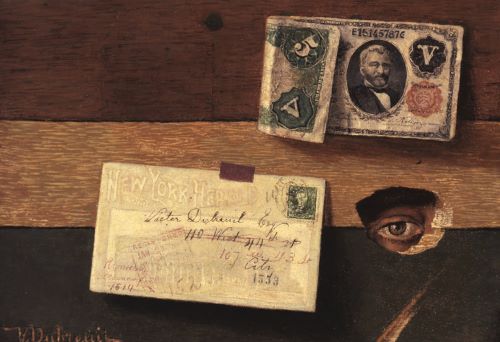
Dubreuil responded not only in print but also in paint, with one of his most autobiographical pictures. Now called The Eye of the Artist, it apparently dates from sometime between 1895 and 1898. Along with Don’t Make a Move!, this enigmatic still life has been interpreted, partly because of the timing and partly because of the artist’s nationality, as influenced by the 1894 Dreyfus affair in France. The allusion is to a Jewish captain in the French army, Alfred Dreyfus, who — chiefly due to strong anti-Semitic feeling — was misidentified, and then framed, as a German spy. Jews at the time were often associated with profit-making banks, and both robbers in Don’t Make a Move! have what some scholars consider to be caricatured Jewish features — a reading troubled by the fact that these figures were based on Dubreuil and his ex-washerwoman. The argument to date has been that Don’t Make a Move! is an anti-Semitic work about Jewish robber-bankers, and, mostly as the result of this conclusion, the picture with the eye and five-dollar bill has also been seen as having a probable anti-Semitic subtext. But the intrinsic evidence does not support this particular reading.12
The Eye of the Artist has actually never been given a satisfactory interpretation. Since Dubreuil is not known to have supplied the painting’s title, the eye is not necessarily even meant to be that of the artist. This motif — a single eye peering through a hole in two wooden planks with a stamped and addressed envelope and a five-dollar bill pasted nearby — is undeniably eccentric and certainly unique in trompe l’oeil painting.
Using Dubreuil’s long-term infatuation with François Rabelais as a point of departure, we can give the painting a new reading.13 When not creating art, Dubreuil worked for more than a decade on an annotated version of the works of this French Renaissance humanist. As his New York World interviewer learned, the artist toiled “day and night to finish the annotations” with the intention of publishing them and explaining Rabelais to “his fellow countrymen and the world”.14 Rabelais is most famous for a series of five satirical and often bawdy books about the genial giant Gargantua and his son, Pantagruel. Essentially, Rabelais attacked established authority, particularly with regard to hypocrisy and repression, and stressed his own perception of individual liberty. Through his Christ-like hero Pantagruel, he promoted a concept he called Pantagruelism, a form of Christian charity. He concluded his second book by advising his readers to avoid hypocrites and dissembling clergymen, referring to an eye: “If you desire to be good Pantagruelists (that is to say, to live in peace, joy, health, making your selves always merry) never trust those men that always peep out at one hole.” He refers here to the clergymen who look out from under a cowl, offering a one-sided or “squint-minded” view. Set within the world of Rabelais, the riveting eye in Dubreuil’s painting thus becomes a symbol of wrong-headed censorship.15

The envelope, “pasted” nearly at the center of the picture, is the most instructive element in that it contains various inscriptions that have autobiographic relevance. Postmarked and addressed to Dubreuil, it carries a New York Herald watermark, including a faint background image of the publisher’s building, as an indication of the sender. Dubreuil could have received such an envelope, sent in reply to his request to be heard, a plea for “justice”, in light of the Herald’s damaging insinuation of his complicity with regard to the barrel paintings. At the bottom left, the word “Removed” relates to the changed addresses on the envelope. Apparently, the Herald’s message — either the real response or, metaphorically, the libelous original — followed the artist as he moved.
The rest of the inscriptions likely constitute Dubreuil’s reply. At lower left, “1614” is one of a series of cryptic numeric references to historic benchmarks in an international struggle to protect individual freedom from the arbitrary authority of a despot. The date 1614 calls to mind the French Estates General (an assembly of representatives of the clergy, nobility, and commoners), which convened that year as the king’s advisers for the last time and as a precursor to its reappearance before the French Revolution. At the bottom, the stamp also contains the mysterious number “152”, which is the exact height in feet of the Statue of Liberty. The ultimate symbol of American freedom, it was a gift from France to the United States on July 4, 1884. President Cleveland dedicated the statue in New York in 1886, when Dubreuil could have been present. Farther to the right and below the corrected address is the only stamped number, “1553”, the reputed date of Rabelais’ death, writ large and placed as a kind of culmination.16
Through the annotations on the envelope, Dubreuil answered the Herald by aligning himself with obedience to law and the pursuit of orderly freedom. By ending with Rabelais, he emphasized the primacy of charity. Throughout his novels, Rabelais provided a model for “evangelical caritas, love of and goodwill towards one’s neighbour”, a Christian kindness very much in contrast to the distrusting eye or the newspaper’s assumption of complicity in a boodle scheme.17 The Eye of the Artist would not have been understood, without explanation, by Dubreuil’s contemporaries and was therefore undoubtedly painted for the artist’s own satisfaction. The enigmatic quality of the work parallels the allegorical aspects of Rabelais’ writings, which required considerable explanatory annotation. Rabelais even spoke of the need for his readers to act like a dog chewing on a bone in order to “suck out the marrow; that is, my allegorical sense.”18

While The Eye of the Artist provides cryptic clues to its meaning, other works somewhat more straightforwardly give the viewer a sense of the artist’s political concerns and convictions. These include Safe Money, in which he depicts the open and overstuffed vault of a mythical railroad company (North, South, East, and West Railroad), revealing its excessive profits in paper currency as well as in gold and silver coins over a six-month period.19 Dubreuil was clearly attracted to the opportunity of exposing capitalist greed and the astounding profits behind such monopolies.
Another money painting, The Cross of Gold, derives its title not from the artist but from a famous speech that the presidential candidate William Jennings Bryan gave in the same decade in which the work was made. Bryan’s address (now called “The Cross of Gold Speech”) at the 1896 Democratic National Convention in Chicago attacked wealthy easterners for insisting on a gold standard for the country’s currency at the expense of the average worker, who would be better off with a silver or a bimetallist standard. Bryan electrified his audience when he ended with the memorable words: “You shall not crucify mankind upon a cross of gold.”20 Shortly afterward, a caricature of Bryan giving the speech depicted him waving a crown of thorns and holding a huge golden cross. Dubreuil’s creation, however, in its striking originality, does not fit this iconography and is not convincing as the “literal embodiment”, as has been argued, of a contemporaneous politician’s rant.21 In the traditional position of the Virgin Mary is a depiction of Martha Washington, an “exemplary” historical figure associated with the founding of the nation. Placed this way, she appears to be chief worshiper in a farce.22 The words “United States” on the topmost silver certificate seem to confirm that this object of adoration can be interpreted as a satire of the country’s worship of money, particularly in this time of financial difficulty.

As a painted subject, currency increased in popularity among still-life painters in New York at the end of the century. Compared with his competitors, Dubreuil was less prolific and more uneven an illusionist than most. In fact, some of his bank notes are quite loosely painted and mostly fanciful, as in a second robbery picture, A Hard Day’s Work. Yet while his pictures could be cruder or less exact than those of his better-known contemporaries, they were also more strident in content. Alfred Frankenstein, who in 1953 was possibly the first art historian to mention Dubreuil, admired and reproduced Don’t Make a Move! as the artist’s masterpiece, later noting with approval its “vein of stark brutality”.23 The art historian Bruce Chambers had good reason, in surveying money paintings of the period, to note that Dubreuil’s images were “the most individual of them all”.24 In fact, Dubreuil’s societal warnings are more daring and socially critical than the subjects of nearly all — if not all — of his contemporaries. These images have no known fine art counterparts in the period.25
Dubreuil returned to France by 1900 when he had one of his inventions — a life-saving boat — shown in the American section of the International Exposition in Paris, with his New York address listed in the catalog. If this were not sufficient reason for him to cross the Atlantic, there was another. The American federal authorities had an increasing suspicion that he was engaged in counterfeiting.26 In 1897 a Treasury Department Secret Service agent, acting on a law prohibiting the reproduction of currency in any form, ordered the removal of Dubreuil’s painting A Barrel of Money from a New York “beanery” until the U.S. district attorney could give an opinion as to its legality. Almost two years later, a similar barrel picture by Dubreuil, “considered by artists a valuable piece of art”, was confiscated from a Boston shop window and sent to the head of the Secret Service, Chief Wilkie, in Washington.27

Fortunately, Dubreuil left a paper trail in France and what survives — although meager — contributes to the context for his American work. He was no ordinary burglar but, rather, an idiosyncratic moralist who wrote not only a financial column for his socialist journal but also a satirical counterpart concerned with unmasking social, political and financial corruption. Titled “Moralisons!” or “Let’s Moralise!”, the column, with its humor and criticism, has much in common with the pictures.28
Likewise, during his army stint as a colonel in the Franco-Prussian War (1870–71), Dubreuil separated himself from his comrades and departed from orders so as to follow his own moral code. That is, he complained about ill-equipped, untrained soldiers and, when nothing was done, resigned rather than lead them into battle. Then, to fulfill his patriotic duty, he rejoined at the lowest rank. At the time, he wrote, in relation to those above him, he had never been anyone’s courtier, meaning he could not be bought. Evidently, the stolen bank money was also less purely selfish than appears. He had become involved in supposedly “vast” financial enterprises and part of it related to the quixotic African plan that went awry. Perhaps in this regard, as he told the Tribune interviewer, he had trustingly worked with others and been ruined by “capitalists”.29
Dubreuil continued to paint pictures in France, but, as far as is known, the extant work is not comparable in ingenuity to the best of his New York canvases. Nor is it as numerous, suggesting a possible death date near 1900, when his location (outside of Paris) is last known.30 Reflecting methods he learned from Rabelais, many of Dubreuil’s American pictures are contrived to be indirect in their meaning. Like The Eye of the Artist, the paintings Don’t Make a Move!, Safe Money, and The Cross of Gold have to be chewed on to get out their marrow-like essence. Clearly the odd dates, numbers, and strange juxtapositions are evidence of the artist’s propensity to tempt his audience to interact with his pictures. They provide an intriguing, hint-based game of guessing. As is evident, they also tend to involve a moralizing twist.
Appendix
Endnotes
- “Paints Millions but Hasn’t a Cent: Victor Dubreuil Has Been a Little of Everything, but Still Hopes to Make a Fortune”, New York World, October 8, 1893, 13. A second, slightly different version, without mention of the nephew, appeared in Columbia, South Carolina, as “Queer and Gifted: An Artist Who Paints Money Like the Real Thing”, State, December 14, 1893, 6, copied from the St. Louis Post-Dispatch. Both versions, especially the second, circulated widely. The nephew is identified as “an employee at Tuxedo Park” in the first version.
- “Paints Millions”, 13, identifies Dubreuil as an inventor; his patent applications give his full name, which is used in the records in France. His birth record is in Ayron Commune, 1833–1842, Naissances, Mariages, 9E 22/6, no. 28, Archives of the Department of Vienne, Poitiers. His marriage record, mentioning his father and a brother (witness) who was a journalist, is in Mariages, 3e arr., V4E 2761, 29/05/1878, no. 377, Archives of Paris. His co-founder was the socialist activist Victor Meunier; a full run of the newspaper, April 17 – October 18, 1881, is in the Bibliothéque Nationale, Paris. The misappropriation of funds and flight toward Holland are in La revue économique et financière, October 29, 1881, 735. The quotations and other information are from “Paints Millions”, 13. His interviewer called him a bank clerk, but he was a founding director of a “bureau de change”. For this, see his divorce record, “1897, Mariages”, 03 (V4E 8190), 19, no. 945, Archives of Paris.
- His arrival date is given in the naturalization record for Marie V. T. Dubreuil, June 5, 1888, vol. 625, no. 132, Common Pleas Court, New York City. Christian Muller witnessed his naturalization and gave the same address as the artist’s, 225 Fifth Avenue, perhaps a boardinghouse. His divorce, on December 21, 1896, is recorded on his marriage record cited above. Because of French law, the divorce would not have been possible before 1884 or while Dubreuil resided in France. Other information is from “Paints Millions”, 13. The suspenders patent (no. 386,973), dated July 31, 1888, and patents for an improvement in the construction of vessels (no. 536,135), dated March 19, 1895, and for a ball-bearing device (no. 550,100), dated November 19, 1895, are at the United States Patent and Trademark Office, Alexandria, Virginia. In his application, Dubreuil assigned title to the ball-bearing device to Howard J. Dietz of New York, implying he had sold it.
- On the earliest such illusionist painting, see Edward J. Nygren, “The Almighty Dollar: Money as a Theme in American Painting”, Winterthur Portfolio 23, no. 2–3 (Summer–Autumn 1988): 131. According to Alfred Frankenstein, Dubreuil “apparently” traded paintings for sustenance at the saloon; Frankenstein, “Saloon Salons”, Art News 67 (September 1968): 64. He derived this impression from Kay Murphy’s article “Paintings from the Past”, Miami Herald, February 2, 1964, 8G, based on an interview with the daughter-in-law of William Roach, one of Dubreuil’s key patrons. The quotations are from “Paints Millions”, 13. I suggest changing the date for Take One from the traditional “1880/90” to “1886 or later”. See the dating of the bank notes in Robert Friedberg, Paper Money of the United States: A Complete Illustrated Guide with Valuations, with additions and revisions by Ira S. Friedberg and Arthur L. Friedberg (Clinton, N.J.: Coin & Currency Institute, 1953; rev. ed., 1995), 22, 58.
- For a discussion of this painting as a portrait of Dubreuil and his “ex-washerwoman”, see Jonathan Clancy’s “Victor Dubreuil: His life details and a self portrait” (November 16, 2011), available here.
- The painting title and the identification of the robbers are from “Paints Millions”, 13. Because of the newspaper date within it, the picture has erroneously been dated 1900 or “after 1900”. Murphy, “Paintings”, illustrates a painting, now called News of All the World (Collisart LLC, New York), by Dubreuil that has a similar format, showing a close, frontal view of a smiling newsboy who holds out a paper to the viewer from behind the newsstand counter. The typography and illustrations of various international newspapers are reproduced at different angles as an illusionistic feat. A third related painting, Bandit, showing the upper body of a man (in a similar black hat) with a revolver held to his eye and aimed at the viewer, was sold at Aguttes auction house in Paris on June 19, 2000.
- Douglas Steeples and David O. Whitten, Democracy in Desperation: The Depression of 1893 (Westport, Conn.: Greenwood Press, 1998), 3, 22–23, 109. For France and England, see “Gold in European Banks”, Wall Street Daily News, April 24, 1893, [2]; and “The Sherman Law Blamed”, New York Herald Tribune, July 7, 1893, 2. For check refusal and an inside-U.S.A. perspective, see Alexander Dana Noyes, Forty Years of American Finance: A Short Financial History of the Government and People of the United States since the Civil War, 1865–1907 (New York: G. P. Putnam’s Sons, 1909), 194–95. On conspiracy, see “Bland Puts on a Bold Front, Declaring that the Silver Situation Is the Result of a Conspiracy”, New York Herald Tribune, June 29, 1893, 3.
- See Chambers’ estimate plus the missing version mentioned by the reporter (“Queer and Gifted”, 13). Nygren (“Almighty Dollar”, 142n) suggests that the casks filled with money might refer to the millions being made in the business of oil or whiskey, but Dubreuil’s interviewer describes a version with jewels as well, implying that the reference is more general. Bruce Chambers, Old Money: American Trompe l’Oeil Images of Currency (New York: Berry-Hill Galleries, 1988), 76.
- On McNally’s move and so forth, see “Now It Is Williams Accused and with Him Two Captains, a Detective, and Ex-Ward Men”, New York Times, September 12, 1894, 8. See also “Look at This, Mr. Lexow! Straw Bail as a Business and Pocket Picking as a Trade Flourish”, New York Herald, September 23, 1894, 2. The locked box is in “Bribes Paid to Three Captains”, New York Herald, September 12, 1894, 3.
- The first quote is from “Bribes Paid”, 3. The second, third, and fourth quotes are from “Look at This”, 2.
- See “done by an old man” in “Look at This”, 2. The reply appears as “Artist Dubreuil Was Well Paid”, New York Herald, September 30, 1894, 4. The fact that Dubreuil was paid four hundred dollars in 1897 for a barrel picture seems to confirm the higher price. For the bill of sale of this painting to a “Mr. T. O’Brien”, see Sotheby’s, New York, December 3, 1998, sale 7230, lot 89. Based on listings in the 1897 New York City directory, O’Brien might have been a liquor dealer/saloon owner (three T. O’Briens were).
- Nygren (“Almighty Dollar”, 147, 149) was the first to interpret the two robbers in Don’t Make a Move! as stereotypically Jewish. He also related The Eye of the Artist to period anti-Semitism, mentioning Dreyfus. Chambers agreed with him (Old Money, 78–80) and developed the connection. See his entry on The Eye of the Artist in Master Paintings from the Butler Institute of American Art, ed. Irene S. Sweetkind (New York: Harry N. Abrams, in association with the Butler Institute of American Art, 1994), 131. Others, such as Marc Shell in Art & Money (Chicago: University of Chicago Press, 1995), 95, continued the anti- Semitic interpretation of Don’t Make a Move!.
- His focus on Rabelais is understandable in that, during this period, this renowned scholar was hailed as possibly the greatest author his native country had ever produced. An outspoken political journalist himself, Dubreuil would have been drawn to Rabelais, who dared to criticize the authoritarian reign of his own king, François I. Moreover, Rabelais’ satirical novels about religion, politics, and society were so dense in meaning, with hidden messages, that they seemed to be open to endless interpretation. This was a suitable challenge for someone with Dubreuil’s literary bent and multipronged ambition.
- “Paints Millions”, 13.
- On Rabelais and Pantagruelism, see Edwin M. Duval, “Pantagruelism”, in The Rabelais Encyclopedia, ed. Elizabeth Chesney Zegura (Westport, Conn.: Greenwood Press, 2004), 178–79. For the eye quote and squint-minded, see François Rabelais, Gargantua and Pantagruel, trans. Sir Thomas Urquhart and Pierre Le Motteux (1929; repr., New York: Alfred A. Knopf, 1994), book 2, chap. 34, 287, 288.
- I am grateful to Pat McCormick, archivist at the Butler Institute of American Art, for his help in reading inscriptions, and to Rebecca Davis, registrar at the Butler Institute, for finding a matching historic photograph of the New York Herald building. Dubreuil gave different addresses in advertisements in the New York Herald for April 14, 1892, 4, and January 18, 1894, 1. The 1894 address is 110 West Forty-Fourth Street, which is his address in the New York City directory for 1895, the last time he appears. The corrected address of 107 West Forty-Third Street also figures in the artist’s 1897 bill of sale for a rendition of Barrels of Money (Sotheby’s, New York, December 3, 1998, sale 7230, lot 89). Dubreuil painted at least one related picture, Letter to Mr. Roach (Kennedy Galleries photo, Frick Art Reference Library), which consists of a slightly torn envelope, addressed to Roach, against a colored field. On the envelope, Roach has the prefix “Mr.”, whereas Dubreuil adds “Esq.” to his own name in The Eye of the Artist, presumably to claim his status as a gentleman.
- For caritas, see Cave in Rabelais, Gargantua, xviii. See also Margaret Harp, “Evangelism”, in Zegura, Rabelais, 73–74.
- The marrow reference is in Rabelais, Gargantua, book 1, introduction, 21.
- The date of “1898 or later” for Safe Money is based on the paint covering the “1898” inscribed at the lower center of the painting. The reworking indicates Dubreuil may have worked on the painting past that date. This date differs from the “c. 1898” published in Sarah Cash, ed., Corcoran Gallery of Art: American Paintings to 1945 (Washington, D.C.: Corcoran Gallery of Art, 2011), 294, and is given with Cash’s permission. The rare inclusion of a date might have marked the fact that this was a landmark year for railroad expansion. Alfred Frankenstein, After the Hunt: William Harnett and Other American Still Life Painters, 1870–1900, rev. ed. (Berkeley: University. of California Press, 1969), xiii, mentions another signed and dated work, an 1893 Barrels of Money, formerly in the William Roach collection and now unlocated. The portraits in Safe Money are, at upper left, Edwin M. Stanton, secretary of war under Presidents Lincoln and Johnson; just below and obscured, U.S. Vice President Thomas A. Hendricks, who died in office in 1885; at lower left, Generals Grant and Sheridan; at bottom center, President James Garfield, who was assassinated in office in 1881; and to the middle right, General James McPherson. See Friedberg, Paper Money, 50, 58–59, 55–56, 66, 67, and 87.
- For The Cross of Gold as an interpretation of Bryan’s speech, with the quotation, see Nygren, “Almighty Dollar”, 148; Chambers, Old Money, 72; and Shell, Art & Money, 88–89.
- For “literal”, see Chambers, in Sweetkind, Master Paintings, 131. By 2010 the connection with Bryan’s speech is stated as a fact in Leo G. Mazow and Kevin M. Murphy, Taxing Visions: Financial Episodes in Late Nineteenth Century American Art (University Park: Pennsylvania State University Press, 2010), 52–54. See Grant Hamilton’s cartoon of Bryan with a gold cross on the cover of the magazine Judge, September 19, 1896. Since The Cross of Gold contains the wrong paper money to make the point, Chambers sees it as painted after Bryan’s defeat and as crucifying greenbacks and silver certificates with the hope of their resurrection (Old Money, 76). I suggest basing the date of Five and Ten Dollar Bills on Friedberg, Paper Money, 54–55.
- For “exemplary”, see “Martha Washington”, New York Herald, October 5, 1886, 6.
- Frankenstein, After the Hunt, xii.
- Chambers, Old Money, 67.
- On the lack of art responding to the depression years of the 1890s, see Steeples and Whitten, Democracy in Desperation, 135. The nearest approximation of the social critique in these paintings appeared in editorial cartoons, which, by necessity, were more obvious.
- See his letter (with a Charenton address) to the editor, The New York Herald [Paris], October 3, 1900, 6, and the Catalogue of Exhibitors in the United States Sections of the International Universal Exposition, Paris: Société Anonyme des Imprimeries Lemercier, 1900, 181 and 512. In his letter, he worried that someone might copy his boat design and mentioned large debts. During the last two decades of the nineteenth century, a time of extensive counterfeiting, other artists who painted images of currency such as John Haberle and Harnett — the latter of whom received a government warning in 1886 — faced the same presumption because of their extraordinary ability to replicate money.
- On the confiscation in New York, see “‘A Barrel of Money’ Hidden Away”, New York Herald-Tribune, April 9, 1897, 4. The Boston incident is in “Painting of a Barrel of Money Seized”, New York Times, June 15, 1899, 3. The agent involved identified the painting as by Dubreuil. He described the picture (20 x 24 in.) as representing “four coin casks filled to over flowing with notes running from $1.00 to $1,000, and in the center, hanging three quarters exposed is a very perfect fac-simile of a $10.00 Silver Certificate, series 1898.” See Ralph Redfern to John K. Wilkie, June 16 and July 3, 1899, in Daily Reports of U.S. Secret Service Agents, 1875–1936, microfilm no. T-915, call no. RG87, roll 259, 743–44, 779–80, National Archives, College Park, Maryland.
- See, for example, his column in La politique d’action, June 3, 1881, 194.
- He was Colonel of the 2nd Marching Regiment of the 1st Brigade in the Army of the North (General Faidherbe) and resigned, December 19, 1870, to become a private. See his complaints, mention of courtier, resignation and rejoining in France, Assemblée nationale (1871-1942), Commission des marchés, Rapports [Paris, 1871-73], 408, 411-12, Archive Division of the National Assembly. See “vastes entreprises” in “Encore un changeur en fuite!”, La petite presse: journal quotidian …, October 31, 1881, n.p. (Gallica). “Paints Millions”, 13. He comes across in his interview, where he mentioned his object in life “to serve” the human race, and in his military record (412) as unusually idealistic.
- There is no record of his return to the United States. Nor is there of his death in the succession of his father or in death records for the area of Paris, 1900 to 1940, or in locations he is known to have visited. I am indebted to Jean Abou for help in trying to trace him.
Public Domain Works
- “Les Tripoteurs”, Le Petit Parisien (1881)
- “Queer and Gifted: An Artist Who Paints Money Like the Real Thing”, The Olneyville Times, copied from the St. Louis Post-Dispatch (1893)
- “Painting of a Barrel of Money Seized”, The New York Times (1899)
Further Reading
- Old Money: American Trompe L’Oeil Images of Currency, by Bruce W. Chambers
- Art & Money, by Marc Shell

